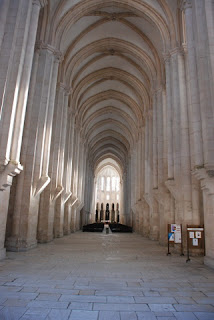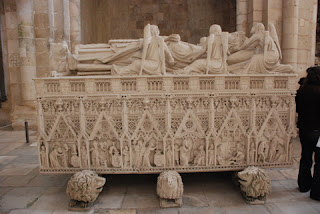


The challenge of the pilgrimage church called us this morning – 700 steps up to it. We walked up arriving just as the clock struck 09:00, the first pilgrims of the day. However our climb was simple compared to the many pilgrims who climb up the steps on their knees. This seems to be a very common form of penance in Portugal and when we visited Portugal before, our apartment was near a nondescript church that for some reason (that nobody could explain to us) had become a pilgrimage centre and people used to climb the very long and steep hill on their knees.
Nossa Senhora dos Remedios, as the name suggests, has a reputation for healing miracles and pilgrims come from all over the country in the hope of a cure or to thank Our Lady for a cure. We were not looking for a cure but the sense of achievement of reaching the top and the view over the town were worth it. We were lucky that the low cloud was just above the church, but as we descended, so did the cloud and the towers of the church started to disappear.
The road that we took out of Lamego climbed quickly and we were soon in fog – there were probably lovely villages and beautiful views on the way but we couldn't see them. Fortunately, about 30 km further on the fog cleared and it turned out to be a lovely sunny and warm day. The scenery was really interesting with large expanses of moorland with very large boulders littering the surface.
Then near Coimbra things went horribly wrong. We knew that sat navs have their problems and one shouldn't follow their directions blindly. As we crossed the river Mondego the instructions weren't that clear (that is my excuse) and I missed the junction off the major road. However, as always, the sat nav gave us new directions to get us back on track and, stupidly, I followed them. It started off OK but the roads gradually got narrower and narrower until I could see that I wasn't going to be able to get Henrietta down the next part of the road. I stopped and was planning my next move when a local man appeared at the window and told me in a gabble of Portuguese that the van would not go down the lane – at least I assume that is what he said. Fortunately, his son arrived and he spoke some English and I explained my plan to turn around at the next turning, just down the hill. He agreed and told us the route to take after that. However, to get to the next turning involved a very narrow part with stone walls on either side and large tree roots sticking out. The clearance was no more than 2 inches, but we made it. Fortunately, there was a large lane to back into but I still needed to get back into the narrow lane. With the expert help of the father (that is the local man not The Father) and Jane hanging out of the passenger window, we achieved it but, given the gradient, I had to slip the clutch a great deal and it was complaining. We then had to negotiate that very narrow part of the lane again but this time going up the steep hill. By the time that we got through it, the smoke was poring off the clutch. A burning clutch creates an awful smell and this permeated the van and came in through the 'fresh air' vents for many days after. As I write this on Tuesday 22nd, the smell has finally dissipated – a welcome relief. I just hope that I have not done any permanent damage to the clutch. I will be much more careful about following the sat nav in the future.
We wound our way through slightly wider lanes until we arrived at Portugal's most important Roman site of Conimbriga just after 14:00.
Conimbriga is a very large (15 hectares) and impressive site lying on the Roman road from Olisipo (Lisbon) to Bracara Augusta (Braga) and part of the Roman road is still on view complete with roadside shops. Only one third of the site has been excavated. The site is surprising on a number of levels: its size; the many mosaics; the destruction of much of the site in Roman times and the reconstruction work that has been done.
There are a large number of beautiful intact mosaics, many of which are uncovered and exposed to the elements. A few have been covered with sand, meaning that they cannot be viewed by the public and the House of the Fountains has a full-scale cover over the building. The latter is very impressive in that the garden in the peristyle has been reconstructed complete with fountains using the original Roman mechanism. The mosaics are also of a very high quality but the walkway around the house is only on two sides and it is very difficult to see the mosaics in any detail. Having said that, the reconstruction work is very effective and it really brings the building to life. There has also been much work in the southern baths complex where the palaestra (exercise area) has been rebuilt. This is also very effective but we started to wonder how much of what we were seeing was reconstruction and how much original. If they had repaired the mosaics, it was difficult to see where.
Although the site was very large, no modern buildings had been built over the centre of the site and this helped to preserve the bases of the buildings. Inevitably, the site had been used as a quarry and the local village was built using the Roman stone. This village does cover the outer part of the site and part of the amphitheatre has been incorporated into it. They have been able to determine the size of the amphitheatre and they estimate that it would hold approximately 10,000 people, the same as the likely population of Conimbriga.
This leads to another interesting facet of the site. Much of the outer part of the site, including much of the amphitheatre, was demolished by the Romans in the late 3rd or early 4th centuries AD. The occupants were very concerned about the possibility of attack, probably from the Suevi people (from eastern Germany). They decided that the original wall was too long to defend so they built a very large wall around a much smaller area at the centre of the site. This was done in a hurry and involved the destruction of many public and private buildings – pillars and inscribed stones were incorporated into the walls.
We enjoyed a drink in the restaurant before finishing the visit in the well presented but small museum on the site.
We had established from the Camperstop Europe book that we were able to stay in the Conimbriga car park overnight and decided to move Henrietta to a slightly more level area. We then met the occupants of the other motorhome in the car park. Marie and Michael were from Devon and were doing the same as us – a year around Europe. Just like us they had not owned a motorhome before setting off on their venture. They are both skiers and had therefore chosen a very nice new Hymer, fully winterised and complete with heating in the garage for drying the ski clothes and equipment. They bought the van in Germany saving 30% on the price in England and, of course, it is left-hand drive like Henrietta, perfect for driving on the continent. We spent ages talking in the car park before heading back to our vans to prepare our meals.
We had heard loud music all afternoon and asked the very helpful guard what it was. The next village 2 km away was having a party with lots of music and dancing – we could go along if we want. I was quite keen but couldn't persuade Jane. Still, we had the music as a lullaby and for much of the rest of the night as well!
Photos: Conimbriga – the huge 'Cantaber's House' with four separate peristyles (courtyards) each with a pond and gardens; The 'Fountain House' with its pond, fountains, garden and exquisite mosaics – note the Minataur Maze on the left with a bull (the Minataur) at its centre; The Conimbriga amphitheatre incorporated into the local village.

















































